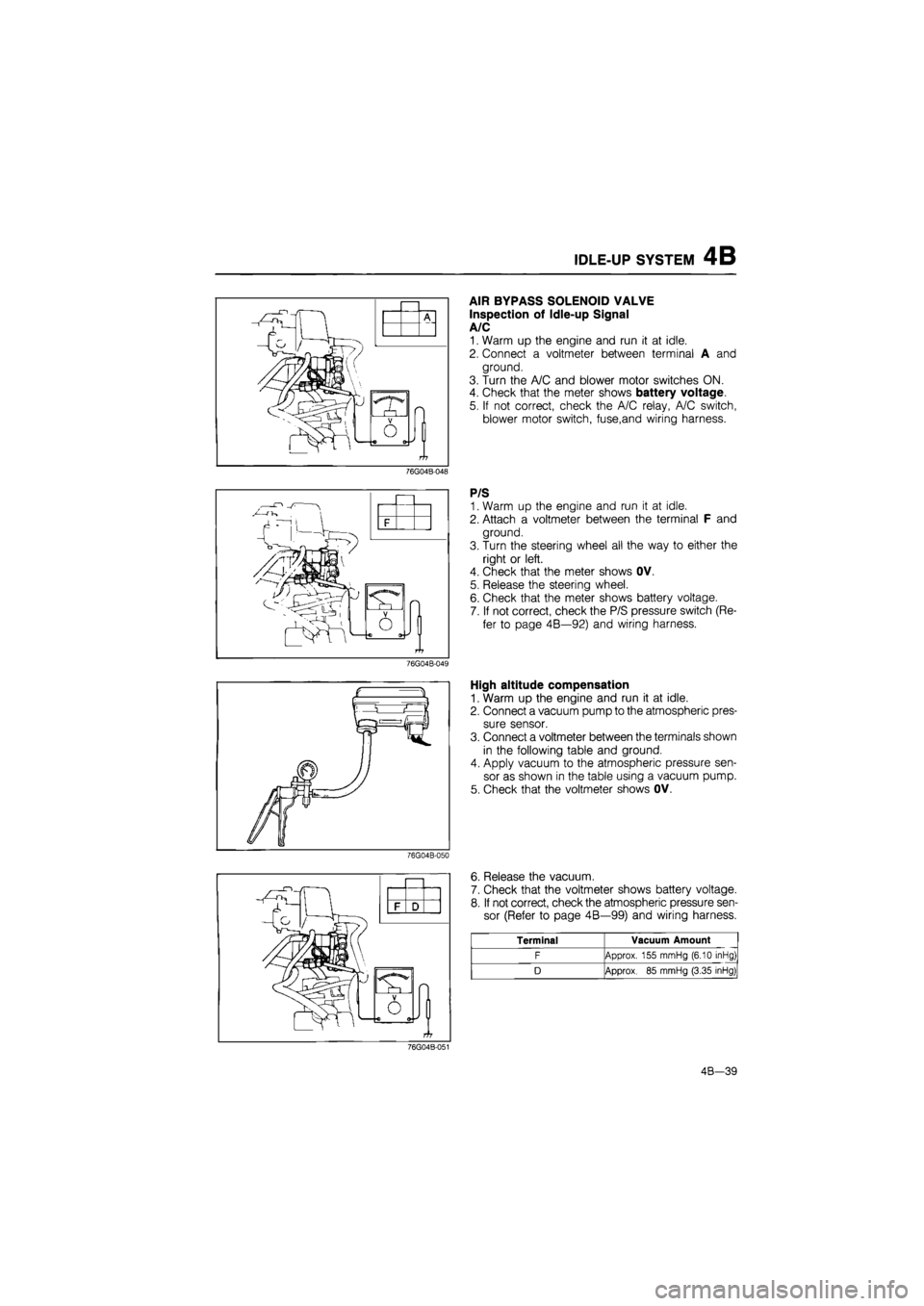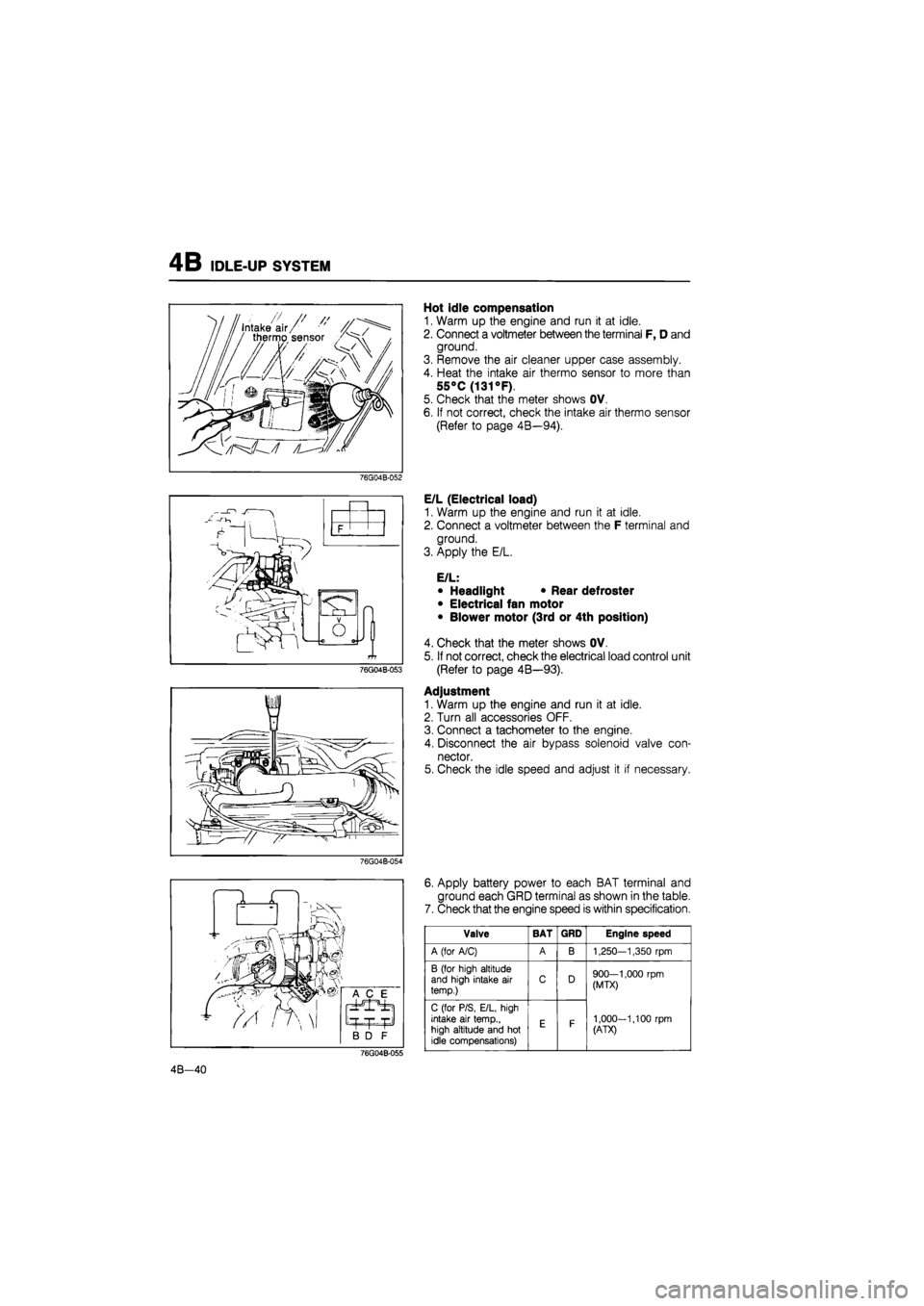engine MAZDA 626 1987 Workshop Manual
[x] Cancel search | Manufacturer: MAZDA, Model Year: 1987, Model line: 626, Model: MAZDA 626 1987Pages: 1865, PDF Size: 94.35 MB
Page 491 of 1865

IDLE ADJUSTMENT 4B
76G04B-034
76G04B-035
Idle mixture
Automatic
Control
Function
Engine Control Unit
IDLE
ADJUSTMENT
IDLE SPEED
Preparation
1) Check the condition of the engine (plugs, leaks in
hoses, etc.).
2) Make sure all accessories are OFF.
3) Warm up the engine and run it for three minutes
at 2,500—3,000 rpm in neutral.
4) Check the initial ignition timing and adjust if
necessary.
Inspection and Adjustment
Caution
Disconnect the air bypass solenoid connec-
tor when checking and adjusting the idle
speed.
1. Check that the idle speed is within specification.
Specification:
MTX—800 +58 rpm
ATX—900 +58 rpm (P range)
2. If the idle speed is not within specification, remove
the blind cap from the throttle body and adjust it
by turning the air adjust screw.
IDLE MIXTURE
Because an automatic compensation function
for air/fuel mixture is built into the engine con-
trol unit, it is not necessary to check and adjust
the idle mixture.
86U04A-049
4B-29
Page 492 of 1865

4B INTAKE AIR SYSTEM
INTAKE AIR SYSTEM
76G04B-036
This system controls the air required by the engine for operation. The system consists of the air duct,
air cleaner, air flow meter, throttle body, dynamic chamber, and intake manifold.
COMPONENT DESCRIPTIONS
Component Function Remarks
Air cleaner
Filters
air
into throttle body
Air flow meter
Detects amount
of
intake air;
sends signal
to
engine control unit Intake
air
thermo sensor and fuel pump
switch are integrated
Throttle body
Controls intake
air
quantity Integrated throttle sensor and idle switch
76G04B-037
4B—30
Page 495 of 1865

INTAKE AIR SYSTEM 4B
76G04B-039
D C B E\\ I I A
p 'V > "
F G
76G04B-040
76G04B-041
1. Check that the throttle valve moves smoothly when
the throttle lever is moved from fully closed to fully
open.
2. Warm up the engine and run at idle.
3. Check the vacuum generated at each port as
shown in the following table.
~ —Condition
Port (Connected to) ——____ Idle Other
A (solenoid valve, EGR) No Yes
B (distributor, advance) No Yes
C (EGR modulator valve) No Yes
D (water thermo valve) No Yes
E (vacuum switch valve
&
charcoal canister) Yes
F (distributor, retard
& air
control valve) Yes
G (distributor, advance) Yes
4. If vacuum is not obtained as in the table, clean the
necessary port.
Dynamic Chamber
1. Visually check the dynamic chamber for damage.
2. Replace, if necessary.
Intake Manifold
1. Visually check the intake manifold for damage.
2. Replace, if necessary.
76G04B-042
4B—33
Page 497 of 1865

IDLE-UP SYSTEM 4B
IDLE-UP SYSTEM
Dynamic chamber
To engine i
lN
Water thermo |ntake air sensor thermo
sensor
E/L control unit
-D
Solenoid A
From air ^^ flow meter ~
Engine
control
unit
Atmospheric pressure sensor
HI
f
"Solenoid B
UJ m
Solenoid C
u
Adjusting screw
| A/C
H-!
relay
IGN switch
-©n
To engine
control
unit
Magnetic clutch
fftf
tr Main relay
r © ©
P/S pressure switch
76G04B-043
Air Valve
This valve is constructed so that the gate valve is opened and closed by means of a bimetal strip and
heat coil. It acts as a fast idle mechanism by opening the gate valve to increase intake air by bypass-
ing the throttle valve while engine is cold, therefore engine speed is increased to shorten the warm
up period.
Air Bypass Solenoid Valve
This valve incorporates three solenoid valves. They operate according to the signal from the engine
control unit or A/C switch in order to achieve idling stability and the optimum idle speed.
The operating conditions of each solenoid valve are as shown below.
Solenoid valve Operating condition
A A/C operated
B Intake air temp, above 55°C (131 °F)
or
vehicle
at
above 1,000
m
(3,280
ft)
C P/S operated, E/L applied, intake
air
temp, above 55°C (131 °F), pressure regulator solenoid ON
or
vehicle
at
above 1,900
m
(6,232
ft)
4B-35
Page 498 of 1865

4B IDLE-UP SYSTEM
COMPONENT DESCRIPTIONS
Component Function Remarks
Air bypass solenoid
valve
Controls bypass
air
amount Operates A: A/C
: ON
B: Intake
air
temp, high
or at
high
al-
titude C: P/S
:
ON, E/L applied
or
hot start
Air valve
When cold, supplies bypass
air
into
dy-
namic chamber
• Engine speed increased
to
shorten
warm-up period
• Bimetal type
Atmospheric pressure sensor
Detects atmospheric pressure; sends sig-
nal
to
engine control unit
E/L control unit
Detects electrical load applied; sends sig-nal
to
engine control unit
Engine control unit
Detects signals from input sensors and switches; controls
air
bypass solenoid valve
Intake air thermo sensor
Detects intake
air
temperature; sends sig-
nal
to
engine control unit
Installed
in air
flow meter
P/S pressure switch
Detects P/S operation; sends signal
to
engine control unit P/S:
ON
when steering wheel turnefl right
or
left
76g04b-044
4B-36
Page 499 of 1865

IDLE-UP SYSTEM 4B
TROUBLESHOOTING
Check the condition of the wiring harness and connectors before checking the sensors or switch.
Possible
cause
\ Page
Symptom
Air valve
Air bypass solenoid valve Engine control unit
terminal
Possible
cause
\ Page
Symptom
Air valve
Idle-up singal Adjustment
Engine control unit
terminal
Possible
cause
\ Page
Symptom
Air valve
Idle-up singal Adjustment
1S 20
Possible
cause
\ Page
Symptom 4B—38 4B—39 4B—40 4B—89 4B—90
Engine
stalls
While warming up
1 2 3 4 5
Engine
stalls After warming up
1 2 3 4
Rough Idle
While warming up
1 2 3 4 5
Rough Idle After warming up
1 2 3 4
High idle speed after warming up
1 2 3 4 5
Runs rough on deceleration
1 2 3 4
Afterburn in exhaust system
1 2 3 4 5
Fails emission test
1 2 3 4 5
76G04B-045
4B-37
Page 500 of 1865

4B IDLE-UP SYSTEM
AIR VALVE
Pre-inspection
1. Start the engine and run it at idle.
2. Pinch the bypass air hose and check that the en-
gine rpm drops.
When engine still cool RPM reduced
After warming-up RPM drop within
200 rpm
3. If the speed is not reduced when cold, check the
air valve, or check for vacuum leaks at the bypass
air hose.
4. If the speed drop is more than 200 rpm when
warm, check the air valve and current to the valve.
Inspection of Terminal Voltage
1. Disconnect the connector from the valve.
2. Remove the rubber boot from the connector.
3. Start the engine and run it at idle.
4. Check that there is battery voltage at terminal (WY),
using a voltmeter.
5. If not correct, check the circuit opening relay and
wiring harness.
76G04B-046
Inspection of Air Valve
1. Check the valve for operation.
Temperature 20°C (68°F) Valve open
(When engine cool)
After warming-up Valve closed
2. Replace valve if faulty.
76G04B-047
4B—38 expert22 Arm http://rutracker.org
Page 501 of 1865

IDLE-UP SYSTEM 4B
AIR BYPASS SOLENOID VALVE
Inspection of Idle-up Signal
A/C
1. Warm up the engine and run it at idle.
2. Connect a voltmeter between terminal A and
ground.
3. Turn the A/C and blower motor switches ON.
4. Check that the meter shows battery voltage.
5. If not correct, check the A/C relay, A/C switch,
blower motor switch, fuse,and wiring harness.
76G04B-048
P/S
1. Warm up the engine and run it at idle.
2. Attach a voltmeter between the terminal F and
ground.
3. Turn the steering wheel all the way to either the
right or left.
4. Check that the meter shows OV.
5. Release the steering wheel.
6. Check that the meter shows battery voltage.
7. If not correct, check the P/S pressure switch (Re-
fer to page 4B—92) and wiring harness.
76G04B-049
High altitude compensation
1. Warm up the engine and run it at idle.
2. Connect a vacuum pump to the atmospheric pres-
sure sensor.
3. Connect a voltmeter between the terminals shown
in the following table and ground.
4. Apply vacuum to the atmospheric pressure sen-
sor as shown in the table using a vacuum pump.
5. Check that the voltmeter shows OV.
76G04B-050
J
O
6. Release the vacuum.
7. Check that the voltmeter shows battery voltage.
8. If not correct, check the atmospheric pressure sen-
sor (Refer to page 4B—99) and wiring harness.
Terminal Vacuum Amount
F Approx. 155 mmHg (6.10 inHg)
D Approx.
85
mmHg (3.35 inHg)
76G04B-051
4B-39
Page 502 of 1865

4B IDLE-UP SYSTEM
76G04B-052
76G04B-053
76G04B-054
Hot idle compensation
1. Warm up the engine and run it at idle.
2. Connect a voltmeter between the terminal F, D and
ground.
3. Remove the air cleaner upper case assembly.
4. Heat the intake air thermo sensor to more than
55°C
(131
°F).
5. Check that the meter shows OV.
6. If not correct, check the intake air thermo sensor
(Refer to page 4B—94).
E/L (Electrical load)
1. Warm up the engine and run it at idle.
2. Connect a voltmeter between the F terminal and
ground.
3. Apply the E/L.
E/L:
• Headlight • Rear defroster
• Electrical fan motor
• Blower motor (3rd or 4th position)
4. Check that the meter shows OV.
5. If not correct, check the electrical load control unit
(Refer to page 4B—93).
Adjustment
1. Warm up the engine and run it at idle.
2. Turn all accessories OFF.
3. Connect a tachometer to the engine.
4. Disconnect the air bypass solenoid valve con-
nector.
5. Check the idle speed and adjust it if necessary.
6. Apply battery power to each BAT terminal and
ground each GRD terminal as shown in the table.
7. Check that the engine speed is within specification.
76G04B-055
Valve BAT GRD Engine speed
A (for A/C) A B 1,250—1,350
rpm
B (for high altitude and high intake
air
temp.) C D 900—1,000
rpm
(MTX)
1,000-1,100
rpm
(ATX)
C (for P/S, E/L, high intake
air
temp., high altitude and
hot
idle compensations)
E F
900—1,000
rpm
(MTX)
1,000-1,100
rpm
(ATX)
4B—40
Page 505 of 1865

FUEL SYSTEM 4B
COMPONENT DESCRIPTIONS
Component Function Remarks
Air flow meter
Detects amount
of
intake
air;
sends signal
to
engine control unit Intake
air
thermo sensor and fuel pump
switch
are
integrated
Atmospheric pressure sensor
Detects atmospheric pressure; sends sig-nal
to
engine control unit
Circuit opening relay
Voltage
for
fuel pump while engine running
Clutch switch
Detects in-gear condition; sends signal
to
engine control unit Switch
ON
when clutch pedal released
Engine control unit
Detects signals from input sensors and switches; controls injector operation
Fuel filter
Filters particles from fuel
Fuel pump
Provides fuel
to
injectors • Operates while engine running
• Installed
in
fuel tank
Idle switch
Detects when throttle valve fully closed;
sends signal
to
engine control unit
Installed
in
throttle sensor
Ignition coil (-) terminal
Detects engine speed; sends signal
to
engine control unit
Ignition switch (ST position)
Sends engine cranking signal
to
engine control unit
Inhibitor switch
Detects in-gear condition; sends signal
to
engine control unit
Switch
ON in "N" or "P"
range
Injector
Injects fuel into intake port • Controlled
by
signals from engine control unit • High-ohmic injector
Intake air thermo sensor
Detects intake
air
temperature;
sends signal
to
engine control unit Installed
in air
flow meter
Main relay
Supplies electric current
to
injectors and engine control unit
Neutral switch
Detects in-gear condition; sends signal
to
engine control unit
Switch
ON
in-gear
Oxygen sensor
Detects Oxygen concentration; sends sig-nal
to
engine control unit
Zirconia ceramic and platinum coating
Pressure regulator
Adjusts fuel pressure supplied
to
injectors
Pulsation damper
Absorbs fuel pulsation
Throttle sensor
Detects throttle valve opening angle; sends signal
to
engine control unit
Integrated idle switch
Water thermo sensor
Detects coolant temperature;
sends signal
to
engine control unit
Water thermo switch
Detects radiator coolant temperature; sends signal
to
engine control unit ON: above 17°C (63°F)
76G04B-058
4B—43